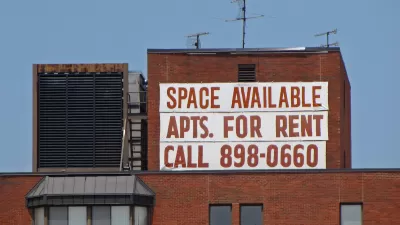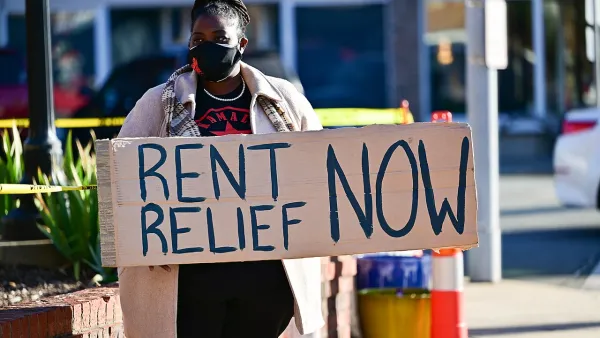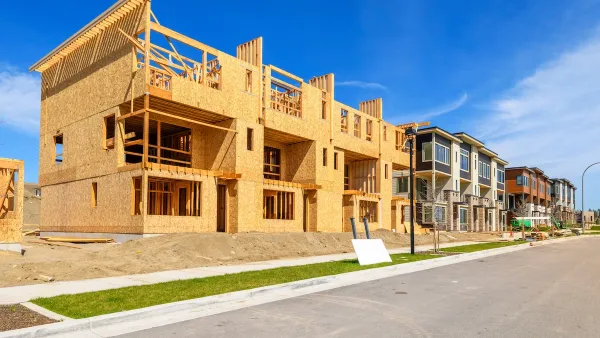A new report examines the impacts of the mortgage meltdown on rental housing.
"The current mortgage turmoil reaches deep into rental markets. New research on rental housing market dynamics from Harvard University's Joint Center for Housing Studies finds that the current housing debacle not only adds to the number of households competing for low-cost rentals but also threatens renters living in foreclosed properties with sudden eviction. The report concludes that policy makers at all levels of government should focus more attention on those renter households severely harmed by the current mortgage market turmoil.
"Today, investor-owned one- to four-family rental properties account for nearly 20 percent of all foreclosures," notes Nicolas P. Retsinas, director of the Joint Center. "Moreover, because many of the high-risk home purchase and home refinance loans now in default are concentrated in low-income and minority communities, the fallout from foreclosures is hitting the same neighborhoods where many of the nation's most economically vulnerable renters live."
The report entitled America's Rental Housing: The Key to a Balanced National Policy examines recent mortgage market events in the context of long-standing affordability problems that plague millions of renters. Fueled by record foreclosures and sluggish home sales, the share of households owning a home is declining, while the number of renter households jumped by nearly one million last year, or more than four times the pace of renter growth over the 2003 to 2006 period. Despite the growing signs of economic weakness, monthly rents last year reached a record high of $775.
The report also observes that rising foreclosures and the resulting turmoil in credit markets raises the costs of financing rental housing construction and preservation. Last year, completions of multifamily units for rent fell to 169,000 units – just two thirds of the 2002 figure and only one-third of the 1986 record high. The blighting influence of vacant and foreclosed properties also will accelerate the abandonment of low-cost rental properties in distressed neighborhoods, further limiting the supply of affordable housing.
While acknowledging the importance of efforts to assist homeowners facing foreclosure, the report proposes the development of a new and more balanced set of housing policy initiatives that would expand opportunities for renters and homeowners alike. "For the past decade, broader access to homeownership has been the centerpiece of federal, state, and local housing programs," adds William Apgar, Joint Center Senior Scholar. "The rapid rise in mortgage delinquencies and home foreclosures unfortunately exposes the tragic flaw in this imbalanced approach."
"A balanced national housing policy should focus renewed energy on preserving the stock of subsidized rental housing, limiting losses of privately owned, low-cost units, and eliminating land use restrictions and other barriers that needlessly increase the cost of producing homes for sale as well as for rent," continues Retsinas. "The nation now has an unprecedented opportunity to transform the large inventory of foreclosed and vacant properties into the next generation of affordable rental housing."
Thanks to Jon Cecil, AICP
FULL STORY: Mortgage Turmoil Contributes to Rental Affordability Woes

Planetizen Federal Action Tracker
A weekly monitor of how Trump’s orders and actions are impacting planners and planning in America.

Restaurant Patios Were a Pandemic Win — Why Were They so Hard to Keep?
Social distancing requirements and changes in travel patterns prompted cities to pilot new uses for street and sidewalk space. Then it got complicated.

Map: Where Senate Republicans Want to Sell Your Public Lands
For public land advocates, the Senate Republicans’ proposal to sell millions of acres of public land in the West is “the biggest fight of their careers.”

Maui's Vacation Rental Debate Turns Ugly
Verbal attacks, misinformation campaigns and fistfights plague a high-stakes debate to convert thousands of vacation rentals into long-term housing.

San Francisco Suspends Traffic Calming Amidst Record Deaths
Citing “a challenging fiscal landscape,” the city will cease the program on the heels of 42 traffic deaths, including 24 pedestrians.

California Homeless Arrests, Citations Spike After Ruling
An investigation reveals that anti-homeless actions increased up to 500% after Grants Pass v. Johnson — even in cities claiming no policy change.
Urban Design for Planners 1: Software Tools
This six-course series explores essential urban design concepts using open source software and equips planners with the tools they need to participate fully in the urban design process.
Planning for Universal Design
Learn the tools for implementing Universal Design in planning regulations.
Heyer Gruel & Associates PA
JM Goldson LLC
Custer County Colorado
City of Camden Redevelopment Agency
City of Astoria
Transportation Research & Education Center (TREC) at Portland State University
Camden Redevelopment Agency
City of Claremont
Municipality of Princeton (NJ)





























